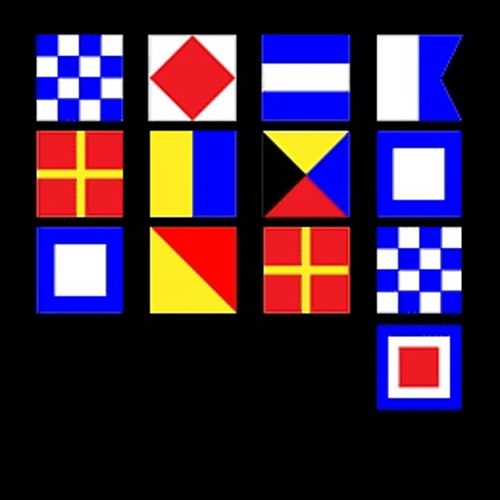
"CHASE OF THE AMERICAN PRESIDENT. OFF NEW YORK, NIGHT OF 15 JANUARY 1815"
Oil on linen, 27.5 x 40 inches (1000 x 700mm) - Limited Edition Print available
Scene depicting fierce action between the US heavy frigate PRESIDENT (nearest), Commodore Stephen Decatur, and the British frigate ENDYMION (left), Captain Henry Hope; the British frigate van of a pursuing squadron also comprising the razee ship-of-the-line MAJESTIC, flag of Commodore John Hayes, and the two other frigates POMONE and TENEDOS, Captains John Lumley and Hyde Parker respectively. Commodore Decatur flies his broad pennant, marked “ P R E S I D E N T ”, which is added after detail illustrated in period paintings of the event by British maritime painter, also sailor of the Napoleonic Wars, Thomas Buttersworth.
In the winter moonlight the sails of both ships, heavily iced, shined as bucketmen doused water, which promptly froze, to close the pores of the canvas to better hold the air; the endeavour evident on PRESIDENT’s topsails & yardarms. A Northwesterly gale had brought snow to sea-level the day before and although the storm had by now broken, the ships were still heavily-weighted with solid-white freezing spray. As standard practice in the US Navy at the time: the same storm was intended to provide cover for PRESIDENT to slip out to sea for a commerce-destroying cruise, past the amassed blockading squadrons of the Royal Navy which held the balance of power throughout the war. Realising his terrible odds at sighting the enemy squadron, Commodore Decatur had lightened ship attempting to avoid capture; cutting away his anchors, along with the boats, and had tipped heavy provisions for a long war cruise over the side.
Able to benefit from a running engagement, yet inferior to PRESIDENT in both size and force, ENDYMION betrays scars of the exchange: the last of her own boats having been smashed to pieces at the quarter davits, her mainbrace cut (and hastily re-spliced), and a 30-foot section of canvas torn from her foresail by a barred shot from the American. By another stroke of luck for the smaller British frigate, PRESIDENT had run afoul of a sandbar as she got out of New York, losing her false keel and being delayed there long enough for Commodore Hayes’ squadron, having earlier been blown out to leeward, to resume its station. Thereby already damaged to an extent not fully known to her crew; and by duress of the chase having had lightened ship in haste, probably to the detriment of her trim and therefore sailing quality, PRESIDENT laboured vulnerably even despite the vastly larger enemy force she faced. PRESIDENT may also have had wet powder, which would have significantly impaired her hitting power, as was observed in first-hand accounts. The sail at right horizon is the POMONE, included to further acknowledge this was not a fair fight. By this stage of the engagement however the ponderous MAJESTIC would have lagged too far behind, and TENEDOS been too far to the South for either to be shown. POMONE would have come into the action earlier, if not for having been dispatched the preceding morning to investigate a sail to Eastward, which turned out to be TENEDOS as she joined the squadron. This composition represents the culminating moments of the first phase of the action, just before about 8:00PM and immediately prior to ENDYMION retiring from the fray to make repairs and bend new sail; this allowed both POMONE and TENEDOS to overhaul ENDYMION and draw within range of the PRESIDENT, so beginning the second and final phase of the action.
PRESIDENT would be captured, a lawful prize notwithstanding that the Treaty of Ghent had been signed but three weeks prior, ending the War of 1812. The British blockade of American ports and commerce still stood until the treaty unseated war-orders on the North American Station. Commodore Decatur, among the wounded in the action, would be honourably acquitted for the loss of PRESIDENT, having been taken by an enemy squadron of superior force. The captured PRESIDENT was closely studied by the British, being the only ship ever captured of the three ships in her class, which had achieved such notoriety through their series of humiliating defeats over British frigates throughout the War of 1812. Commodore Decatur, a rightfully esteemed figure in the US Navy, had in fact commanded the ‘Wagon of the US Navy’, the heavy frigate UNITED STATES of this same class, during her victory over the British frigate MACEDONIAN three years prior. The chivalry of then-Captain Decatur cannot be overstated, considering his protest for the forfeiture of that prize, owing to the gross imbalance of fighting force between the two ships.
This piece intends not to understate the gallantry of either side, the odds against Commodore Decatur or the risks taken by Captain Hope engaging a gravely superior ship in a close duel. As American Naval Historian James Fenimore Cooper later wrote: PRESIDENT would fairly easily have carried ENDYMION in a boarding action, but was ultimately denied the power of motion necessary of such an occasion. British losses numbered 11 killed and 14 wounded; figures on American losses vary, up to as many as 35 killed and 70 wounded. In the days immediately after the action ENDYMION, still mauled, with the PRESIDENT as prize, would both be dismasted en-route to the West Indies. PRESIDENT would later arrive in England for a brief period of service with the Royal Navy. This class of heavy frigate having so-impressed its captors, the captured PRESIDENT’s lines were later copied and applied to a British iteration of the same draught. The original designer Joshua Humphreys could take a bow.
